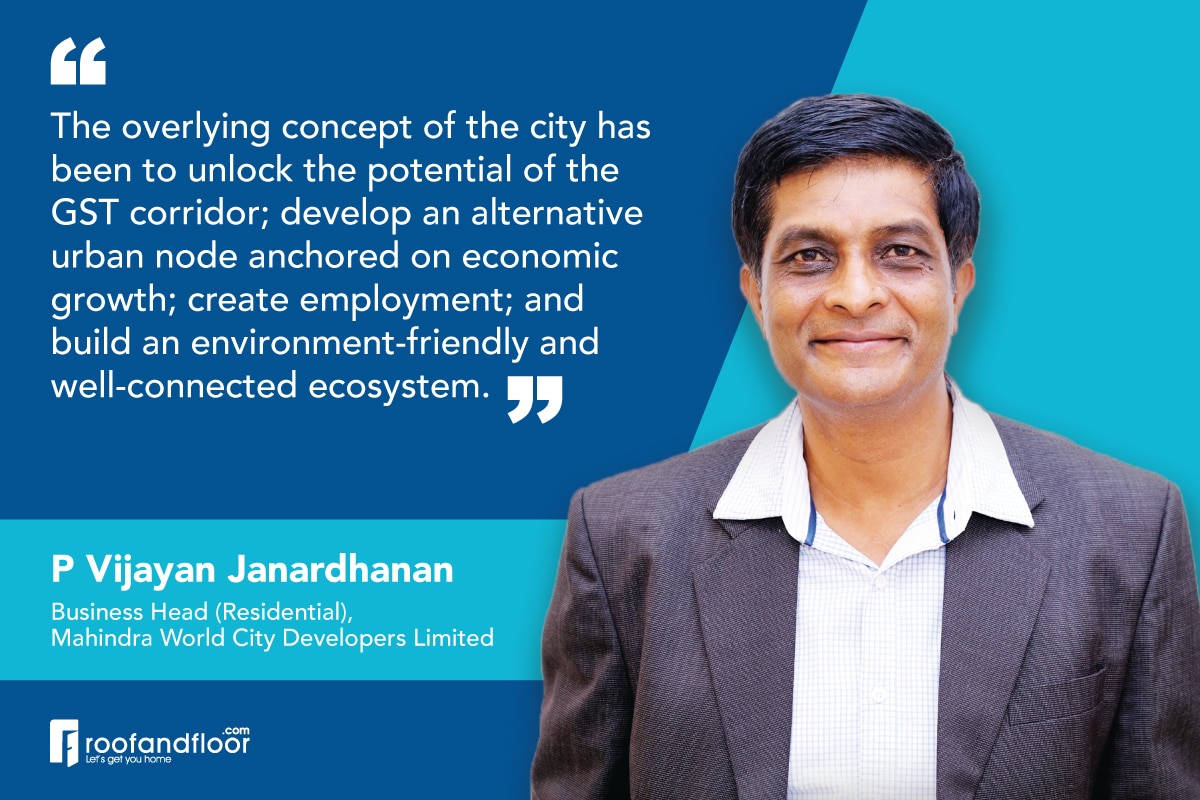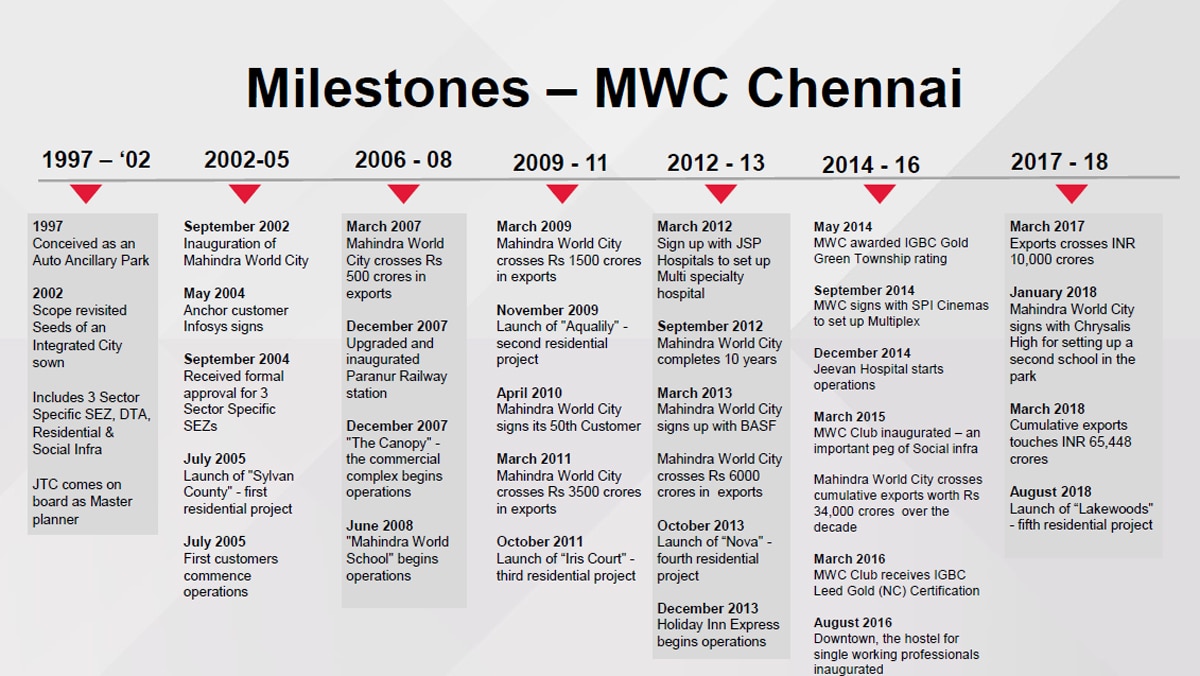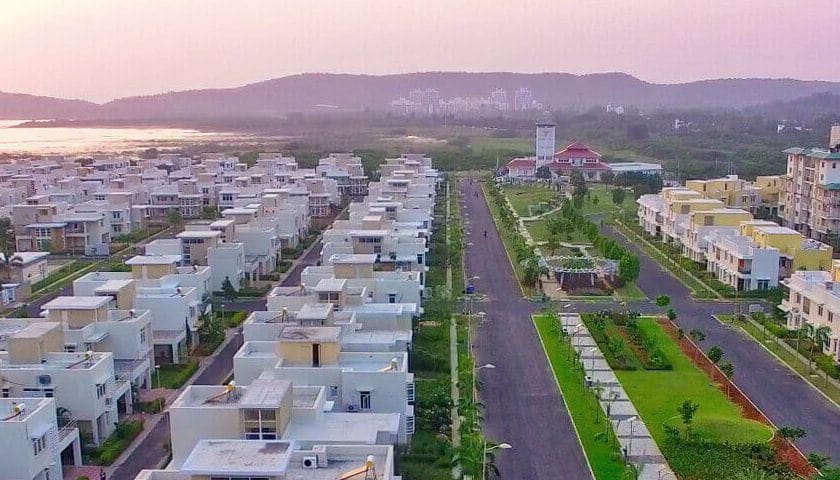About two decades ago, the Tamil Nadu government decided to develop an ancillary automobile park near Chennai. This was when a vast stretch of land on the banks of the Kolavai in Kancheepuram District came into prominence. And what was once barren land transformed into a bustling township where 67 companies and over 2,000 families live, work, and play. It has, undoubtedly, been quite a journey for Mahindra World City.
We had an opportunity to interview P Vijayan Janardhanan, Business Head (Residential), Mahindra World City Developers Limited. In an exclusive interview with RoofandFloor, he spoke about the journey, the company’s expansion plans, and much more.
Here are the excerpts.
What is Mahindra World City, Chennai?
First, let’s call it MWC for the sake of simplicity.
 Developed as an enabling ecosystem for ‘livelihood, living and life’, MWC is India’s first integrated city built in public-private partnership between the Mahindra Group and Tamil Nadu Industrial Development Corporation.
Developed as an enabling ecosystem for ‘livelihood, living and life’, MWC is India’s first integrated city built in public-private partnership between the Mahindra Group and Tamil Nadu Industrial Development Corporation.
The overlying concept of the city has been to unlock the potential of the Grand Southern Trunk (GST) corridor; develop an alternative urban node anchored on economic growth by attracting investments in industrial facilities; create employment; and build an environment-friendly and well-connected ecosystem.
Strategically located on NH 32, it spans over 1,550 acres. It has played a significant role in the development of the GST corridor, which has, in turn, witnessed rapid industrial growth over the years, especially in the automotive, engineering, and allied sectors.
MWC Chennai has created direct employment for more than 39,500 people, and its Special Economic Zones have generated cumulative exports exceeding Rs 71,000 Crore so far.
Who conceptualised the plan for MWC?
The plan was conceptualised by the global planning and architectural firm Jurong Consultants.
How did it all start? How did you finalise the location?
The origin of MWC Chennai can be traced back to 1996 when the government intended to develop an ancillary automobile park near Chennai with private participation in the sector.
The new wave of liberalisation across India that began in 1991 had ushered in economic reform in Tamil Nadu too. Several national and transnational corporations set up operations in Chennai, and the city emerged as a significant global automotive hub. The government was keen to facilitate an ancillary ecosystem and, thus, the seeds of MWC Chennai were sown in 1997.
The land was selected after an extensive survey of the region and terrain. In contrast to the typical flat and dry Chennai terrain, the site had scenic hills and natural lakes nearby, together with rock outcroppings that provided a sense of space.
One of the most significant factors was connectivity – the fact that the site was on the erstwhile NH-45 and had a rail link.
However, what was initially envisioned primarily as an industrial park acquired a much broader shape and form along the way to evolve into the holistically integrated ecosystem that it is today.

Is it a green city?
Yes. It has been designed to integrate resource conservation into its daily operations and has established several environmental firsts. It is India’s first IGBC Gold (Stage 1) certified Green Township and the country’s first food-waste-free integrated city.
What are the three major USPs of MWC Chennai?
• It a green city with sustainability at its core
We have leveraged the principles of healthy and green living by employing world-class environmental practices. These include waste management and segregation, rainwater harvesting, a bio-CNG plant that converts food waste into raw biogas, bike rides service for residents and visitors, among several others.
• A stakeholder-focused, inclusive city of collaborations
We are driven by our mission of transforming urban landscapes by creating sustainable communities. And for that, we have collaborated with government, local communities, industries, citizens, and the Indian Railways.
It is worth mentioning here that our collaboration with Indian Railways resulted in the Paranur Railway Station – a gateway to MWC Chennai that enables convenient and rapid connectivity to Chennai city.
• Master-planned to be responsive and flexible
The city’s layout was designed to ensure flexibility so that smaller modular plots could be amalgamated into larger plots, thereby catering to the diverse needs of a wide range of industrial clients. This approach to flexible, stakeholder-centric development is also reflected in the plan for the social zone, which considers diverse homebuyer needs and accordingly offers a plethora of apartments and villas in multiple configurations, together with an array of social amenities.
Who takes care of the administration of this city? Is it within the municipal limits?
MWC Chennai falls within the ambit of the Directorate of Town and Country Planning and the Chennai Metropolitan Development Authority planning area, and relevant laws are applicable.
Additionally, it is managed by an internal team of experts, who supervise housekeeping, common security and lighting, water supply, sewage treatment, stormwater drainage, waste management, internal transportation, roads, and common infrastructure and landscaping.
Tell us something about the social infrastructure within the project.
We have earmarked a total area of 51 acres for social infrastructure development, of which about 28 acres is already utilised. It includes the CBSE-affiliated Mahindra World School; Holiday Inn Express (a 140-room business hotel); Jeevan Hospitals; MWC Club, a retail/commercial centre medical centre, banks with ATMs and a supermarket; and a hostel for single, working professionals.
The plans to establish a second school and multiplex are currently underway.
How about the residential sector? How many families have already moved in? What is the total capacity?
On the residential front, the city is home to more than 2,000 families. The residential zone exudes openness and connects with the nearby perennial Kolavai Lake. There are multiple projects within the city. These include Sylvan County, Aqualily, Iris Court, and Nova.
Some of the recent residential launches are:
Aqualily Flexi-Homes – The project provides innovatively designed living spaces that enable homeowners to alter internal layouts depending on their needs. This adaptability is delivered via a dynamic wall and intelligent use of furniture.
Lakewoods –The project comprises nine 14-storied towers, with 747 apartments in 2 BHK and 3 BHK configuration spread across 9.33 acres.
What are your plans for 2019?
We are currently focusing on strengthening the ‘living and life’ aspects of MWC Chennai. This encompasses planning and development of new residential projects and augmenting the cultural experience of the city via community-driven events and initiatives.


Thanks for finally writing about >Mahindra
World City: A City Within a City – RoofandFloor Blog <Liked it!
Ӏ liкe thiѕ post, enjoyed thіѕ one appreciatе it fоr putting up.
Thanks for the post, I wonder how this city now in 2021, after the pandemic came up, screw everybody plans and stomping the economy. Hope people will get well soon.